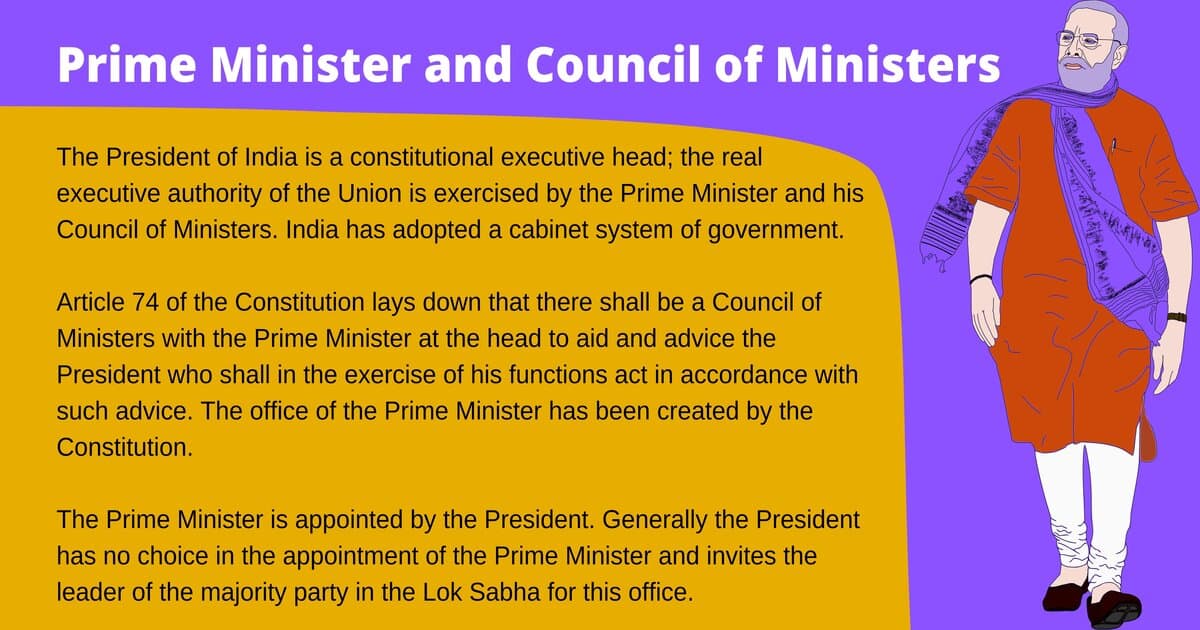Prime Minister and Council of Ministers
by Yuvi - April 2, 2021
The Prime Minister and Council of Ministers
The President of India is a constitutional executive head; the real executive authority of the Union is exercised by the Prime Minister and his Council of Ministers. India has adopted a cabinet system of government.
Article 74 of the Constitution lays down that there shall be a Council of Ministers with the Prime Minister at the head to aid and advice the President who shall in the exercise of his functions act in accordance with such advice. The office of the Prime Minister has been created by the Constitution.
The Prime Minister is appointed by the President. Generally the President has no choice in the appointment of the Prime Minister and invites the leader of the majority party in the Lok Sabha for this office.
Term
The Prime Minister theoretically holds office during the pleasure of the President. Actually the Prime Minister stays in office as long as he enjoys the confidence of the Parliament. The normal term is five years but it is automatically reduced if the house is dissolved earlier.
Powers
The Prime Minister enjoys extensive powers
- He is the Leader of the majority party in the Lok Sabha
- He can recommend the dissolution of Lok Sabha to the President before expiry of its normal term
- All the members of the Council of Ministers are appointed by the President on the recommendation of the Prime Minister.
- He allocates portfolios among the various ministers and reshuffles them according to his wishes. He can ask a minister to resign and even get him dismissed by the President
- He presides over the meetings of the Council of Ministers and exercises a strong influence on its decisions.
- The Prime Minister is the chief channel of communication between the President and the Council of Ministers and keeps the former informed about all the decisions of the council.
Council of Ministers
A minister must be a member of either House of Parliament. If a person who is not a member of either House of Parliament is appointed a minister, he shall cease to be a minister after six months, unless in the meanwhile he manages to get elected to either of the two Houses.
Ministers may be chosen from members of either House and a Minister who is a member of one House, has right to speak in and to take part in the proceedings of the other House though he has no right to vote in the House of which he is not member.
The Council of Ministers is not a single body but a composite body, consisting of ministers of different ranks. The classification is done informally following the British practice. The Ministers are divided into three categories, viz. Cabinet Ministers, Ministers of State and Deputy Ministers.
The Cabinet is an informal body of senior Ministers who form the inner circle. It is like a wheel within a wheel. The Council of Ministers, seldom meets as a body. It is the Cabinet which meets as and when summoned by the Prime Minister.
Principles on which the Cabinet system of Government functions-
(1) The parliamentary form of government is based on the principle of collective responsibility. Article 75(3) of the Constitution states that the Council of Ministers is collectively responsible to the Lok Sabha.
It means that all the Ministers are collectively answerable to the Lok Sabha for the policies and decisions of the government, even though a decision taken may pertain to a single ministry.
The individual ministers may have differences among themselves on certain issues but once a decision is taken by the cabinet it becomes a joint decision of all the Ministers. If a minister does not agree with the decision of the cabinet he has no choice, but to resign. The Council of Ministers works as a team. Thus it swims or sinks together.
(2) Individual Responsibility of Ministers:
Apart from collectively responsible to the Lok Sabha, all ministers are individually responsible to the President. Article 75(2) declares that the ministers hold office during the pleasure of the President.
(3) Role of the Prime Minister:
The Prime minister is the keystone of the cabinet arch. He is central to the formation of the Council of Ministers, central to its life and death. If the Prime Minister resigns or dies the whole Council of Ministers goes out along with him.
The Prime Minister is the “primus inter pares” (first among equals). It is he who summons and presides over meeting of the Cabinet. Moreover he can remove a minister at any time by demanding a minister’s resignation or having him dismissed by the President.
The Prime Minister acts as the connecting link between the President and the Cabinet. Article 78 of the Indian Constitution lays down that it is duty of the Prime Minister to communicate to the President all decisions of the Council of Ministers and to furnish such information relating to the administration of the affairs of the Union.
The Prime Minister is also the main link between the Cabinet and Parliament.












